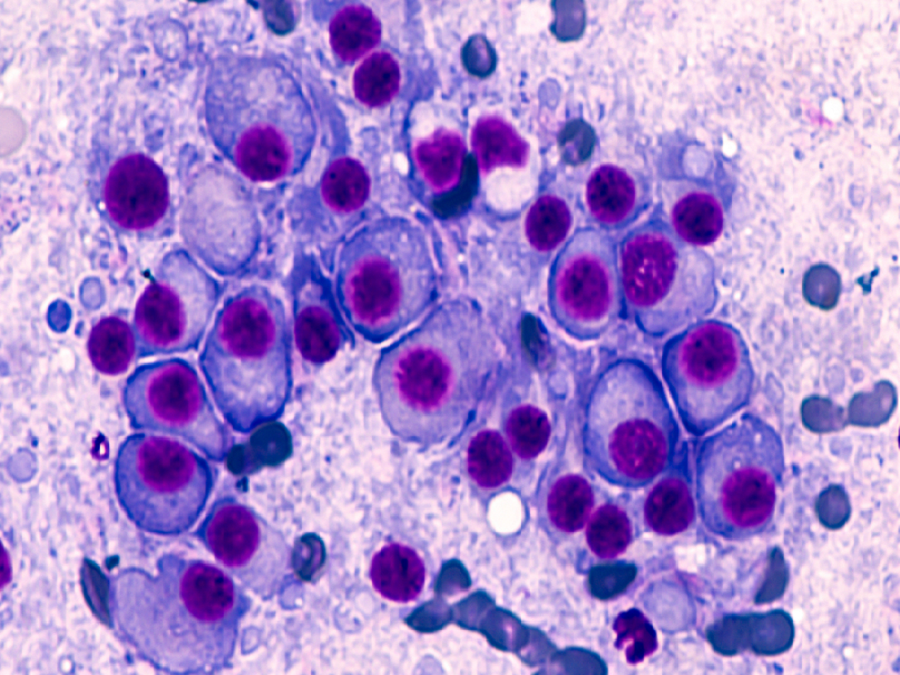
Screening for premalignant precursor conditions could serve as an important step in the early detection and treatment of multiple myeloma. However, more insights are needed to determine the optimal criteria for screening programs, experts say, based on their recently presented research at the 2021 Annual Meeting of the American Society of Hematology (ASH).
By screening for monoclonal gammopathy of undetermined significance (MGUS) and the subsequent smoldering multiple myeloma (SMM) phase—both asymptomatic precursors to multiple myeloma—physicians could monitor the disease from a much earlier stage.
Despite the potential benefit, some have noted that identifying the right approach to screen for MGUS in subjects remains a challenge, particularly in terms of determining those who could develop malignant conditions. Finding the most appropriate age cohort for such screenings also mandates further insight, namely in terms of selecting a cut-off point where patients at an advanced age may not benefit from being diagnosed with the precursor conditions. Furthermore, MGUS screenings could have a potentially harmful psychological impact on those who may not develop the malignant condition.
Recent research findings presented at the 2021 ASH meeting have increased the interest in exploring wide-scale screening programs. One study that recently screened populations at risk of contracting multiple myeloma—African Americans and those having a first-degree relative with a hematological malignancy—found older African Americans have a high prevalence of MGUS and could benefit from screening programs for potential clinical intervention. Similarly, a nationwide screening of over 75,000 Icelandic subjects concluded that population screenings could allow early interventions, but further insight is needed regarding their use in healthy populations.
Screening as the next step in treating multiple myeloma
Multiple myeloma evolves from conditions known as MGUS and SMM, which remain clinically detectable but also premalignant. However, since these precursors can later develop into multiple myeloma, monitoring them presents a potential opportunity for early detection and treatment, experts say.
See Also:
Yet, while screening programs have been implemented to identify solid tumors such as breast or colon cancer, this is not the case for MM, says Catherine Marinac, PhD, assistant professor of medicine at the Harvard Medical School. Marinac participated in the PROMISE study, which looked at individuals at high risk for contracting multiple myeloma.
How well do you really know your competitors?
Access the most comprehensive Company Profiles on the market, powered by GlobalData. Save hours of research. Gain competitive edge.

Thank you!
Your download email will arrive shortly
Not ready to buy yet? Download a free sample
We are confident about the unique quality of our Company Profiles. However, we want you to make the most beneficial decision for your business, so we offer a free sample that you can download by submitting the below form
By GlobalDataIndeed, some blood tests used to screen for multiple myeloma and its premalignant precursors, such as serum protein electrophoresis or free light chain assay, are relatively affordable and available, says Dr Sæmundur Rögnvaldsson, who took part in the Icelandic iStopMM study. Additionally, such measures only require a blood test, rather than a more intensive intervention, says Rögnvaldsson, who is also a PhD candidate at the University of Iceland, Reykjavik.
For example, endoscopy procedures are needed to detect colorectal cancer, while preestablished blood tests for MGUS are much less invasive procedures for the individual subjects, adds Rögnvaldsson.
Dr Sæmundur Rögnvaldsson,PhD candidate at the University of Iceland, Reykjavik
In addition to existing tests, developments in screening technology could also bring new and precise insights into the early detection of multiple myeloma and its premalignant precursors. This is particularly the case with higher-sensitivity matrix-assisted laser desorption ionization-time of flight mass spectrometry (MALDI-TOF MS), which was used in the PROMISE study. This method showed better sensitivity and detected higher rates of MGUS than the conventional testing methods, says Dr Habib El-Khoury, a postdoctoral research fellow at the Dana Farber Cancer Institute in Boston. However, since it is a new non-commercialized method, it must be studied more thoroughly, adds El-Khoury.
As of now, multiple myeloma is often detected at a late stage when the active disease is fully developed with bone lesions and organ damage in subjects, says Rögnvaldsson. But to Rögnvaldsson, advances in using screening for premalignant precursor conditions could change the way multiple myeloma is treated. The key would be detecting the condition in time and being able to not only find those with developed MM, but also trace individuals who are at a higher risk of seeing their precursor conditions develop further and initiate treatment early, he adds.
Timing, scale, and practical use remain a challenge
While potentially an advance in multiple myeloma research, implementing screening programs in the real world comes with its own challenges. According to Rögnvaldsson, the question of which cohort to screen, and the ideal screening age in particular, remains one of the key issues to consider in the potential use in clinical settings.
While the prevalence of MGUS increases with age, with 12.9% being diagnosed with the condition in the 80–103-year age group in the iStopMM study, diagnosing individuals at an advanced age might not be useful, says Rögnvaldsson. This is because the disease is unlikely to advance into further precursor conditions in their lifetime, he adds.
In other words, selecting an appropriate age remains somewhat of a balancing act, where the screening should target those at an advanced enough age to have MGUS, but also young enough to possibly experience the condition worsening, he states. In the iStopMM study, out of 75,422 subjects who were screened for MGUS, 2.3% had the condition in the 40–59 age group, and 6.2% in the 60–79 age group.
As MGUS has a relatively low risk of progression, about 1%, the study’s data can be helpful in determining risk and identifying those who require monitoring, says Rögnvaldsson.
Additionally, participation in screening programs has implications on the subjects’ mental health, say experts. What Marinac sees as a particular challenge is identifying subjects who need to be made aware of the results. To some, an MGUS diagnosis could become a source of anxiety though their risk of progression may be low, says Marinac. In turn, such diagnoses could prove to be a burden to health care systems, she states. Hence, new and more sensitive methods such as MALDI-TOF MS should also be investigated further to identify those who stand to benefit from screening programs, adds Marinac.
Further insight into minority ethnic outcomes
Nevertheless, the ongoing screening research has shed further light on outcome disparity within subjects of African descent, which included data of African American subjects from the Mass General Brigham Biobank. While MGUS appears to be prevalent in roughly 3% of the general population in the United States above 50 years of age, both MGUS and multiple myeloma tend to affect more individuals who identify as Black or African American, as well as those with a relative affected by the conditions, says El-Khoury.
Additionally, members of the African American community tend to be diagnosed with a monoclonal protein, a symptom of having MGUS, at younger ages, says Marinac.
On average, members of the African American community are diagnosed two to three years younger than white subjects
Dr Martin Schoen, assistant professor of medicine at Saint Louis University
Particularly in the older age groups above 50, MGUS was seen in higher percentages in the African American high-risk cohort than in those with a familial link to the indication, says El-Khoury. While 13% of those with family links to MGUS had the precursor condition, 17% had the condition in the African American cohort, adds El-Khoury. Such results detected with mass spectrometry contrasted with a low-risk control group, which was at 10%. As such, at-risk groups, such as those with a familial connection or African Americans and those of African descent, could also be a key cohort to target in screenings, says Rögnvaldsson.
In this sense, although the higher prevalence of MGUS and MM in African Americans has been previously studied, the PROMISE study and advances in screenings could bring further insight to this topic, says El-Khoury.






